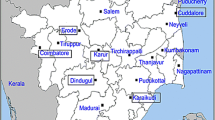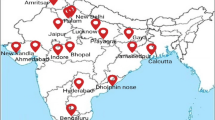Abstract
Wind velocity data modeling plays a crucial role for the estimation of wind load and wind energy. Apart from these, the same modeling must also be used in the load cycle analysis of fatigue failure in slender structures to address periodic vortex shedding. Most authors fitted the entire available range of wind velocities of various locations using Weibull models. However, they did not check the validity of the model in describing the range of extreme wind velocity. In this work, the validity of Weibull models for describing parent as well as extreme hourly mean wind velocity data for four places on the east coast of India has been checked. While it predicts lower wind speeds accurately, the Weibull model has been found to become inappropriate for describing wind velocity in the range of extremes, i.e., above a certain threshold value. Therefore, this article focuses on the techniques of determining a limiting wind velocity beyond which the Weibull distribution is rendered unsuitable. In the range where the Weibull distribution fails, various extreme value distributions, such as Gumbel, Fréchet and reverse Weibull distributions have been compared, thereby determining the best estimator for each location.
Similar content being viewed by others
References
Akdağ, S. A. and Güler, Ö. (2010). “Evaluation of wind energy investment interest and electricity generation cost analysis for Turkey.” Applied Energy, Vol. 87, No. 8, pp. 2574–2580, DOI: 10.1016/J.APENERGY. 2010.03.015.
Ayodele, T. R., Jimoh, A. A., Munda, J. L., and Agee, J. T. (2012). “Wind distribution and capacity factor estimation for wind turbines in the coastal region of South Africa.” Energy Conversion and Management, Vol. 64, pp. 614–625, DOI: 10.1016/J.ENCONMAN. 2012.06.007.
Beccali, M., Cirrincione, G., Marvuglia, A., and Serporta, C. (2010). “Estimation of wind velocity over a complex terrain using the generalized mapping regressor.” Applied Energy, Vol. 87, No. 3, pp. 884–893, DOI: 10.1016/J.APENERGY.2009.05.026.
Bivona, S., Burlon, R., and Leone, C. (2003). “Hourly wind velocity analysis in Sicily.” Renewable Energy, Vol. 28, No. 9, pp. 1371–1385, DOI: 10.1016/S0960-1481(02)00230-6.
Brabson, B. B. and Palutikof, J. R (2000). “Tests of the generalized Pareto distribution for predicting extreme wind speeds.” Journal of Applied Meteorology, Vol. 39, No. 9, pp. 1627–1640.
Cabello, M. and Orza, J. A. G (2010). “Wind speed analysis in the province of Alicante, Spain: Potential for small-scale wind turbines.” Renewable and Sustainable Energy Reviews, Vol. 14, No. 9, pp. 3185–3191, DOI: 10.1016/J.RSER2010.07.002.
Calif, R. (2012). “PDF models and synthetic model for the wind velocity fluctuations based on the resolution of Langevin equation.” Applied Energy, Vol. 99, pp. 173–182, DOI: 10.1016/J.APENERGY. 2012.05.007.
Carapellucci, R. and Giordano, L. (2013). “A methodology for the synthetic generation of hourly wind velocity time series based on some known aggregate input data.” Applied Energy, Vol. 101, pp. 541–550, DOI: 10.1016/J.APENERGY2012.06.044.
Carta, J. A., Ramirez, P., and Velazquez, S. (2009). “A review of wind speed probability distributions used in wind energy analysis: Case studies in the Canary Islands.” Renewable and Sustainable Energy Reviews, Vol. 13, No. 5, pp. 933–955, DOI: 10.1016/J.RSER2008. 05.005.
Carvalho, D., Rocha, A., Santos, C. S., and Pereira, R. (2013). “Wind resource modeling in complex terrain using different mesoscale -microscale coupling techniques.” Applied Energy, Vol. 108, pp. 493–504, DOI: 10.1016/J.APENERGY2013.03.074.
Castillo, E., Hadi, A. S., Balakrishnan, N., and Sarabia, J. M. (2005). Extreme value and related models with applications in engineering and science, John Wiely & Sons, Inc., Hoboken, NJ, USA.
Celik, A. N. (2004). “On the distributional parameters used in assessment of the suitability of wind velocity probability density functions.” Energy Conversion and Management, Vol. 45, Nos. 11–12, pp. 1735–1747, DOI: 10.1016/j.enconman.2003.09.027.
Celik, A. N. and Kolhe, M. (2013). “Generalized feed-forward based method for wind energy prediction.” Applied Energy, Vol. 101, pp. 582–588, DOI: 10.1016/J.APENERGY2012.06.040.
Chang, T. P. (2011). “Estimation of wind energy potential using different probability density functions.” Applied Energy, Vol. 88, No. 5, pp. 1848–1856, DOI: 10.1016/J.APENERGY2010.11.010.
Chen, K. and Yu, J. (2014). “Short-term wind velocity prediction using an unscented Kalman filter based state-space support vector regression approach.” Applied Energy, Vol. 113, pp. 690–705, DOI: 10.1016/J.APENERGY.2013.08.025.
Cook, N. J. (2001). “Discussion on modern estimation of the parameters of the Weibull wind velocity distribution for wind energy analysis.” Journal of Wind Engineering and Industrial Aerodynamics, Vol. 89, No. 10, pp. 867–869, DOI: 10.1016/S0167-6105(00)00088-X.
D'Amico, G., Petroni, R., and Prattico, F. (2015). “Wind speed prediction for wind farm applications by extreme value theory and copulas.” Journal of Wind Engineering and Industrial Aerodynamics, Vol. 145, pp. 229–236, DOI: 10.1016/J.JWEIA.2015.06.018.
Douak, F., Melgani, F., and Benoudjit, N. (2013). “Kernel ridge regression with active learning for wind velocity prediction.” Applied Energy, Vol. 103, pp. 328–340, DOI: 10.1016/J.APENERGY.2012.09.055.
El-Wakil, M. M. (2002). Power plant technology, McGraw-hill International Editions, New York, NY, USA.
Fadare, D. A. (2010). “The application of artificial neural networks to mapping of wind velocity profile for energy application in Nigeria.” Applied Energy, Vol. 87, No. 3, pp. 934–942, DOI: 10.1016/ J.APENERGY.2009.09.005.
Garcia, A., Torres, J. L., Prieto, E., and Francisco, A. de (1998). “Fitting wind velocity distributions: a case study.” Solar Energy, Vol. 62, No. 2, pp. 139–144, DOI: 10.1016/S0038-092X(97)00116-3.
Gugliani, G. K., Sarkar, A., Ley, C., and Mandai, S. (2018). “New methods to assess wind resources in terms of wind speed, load, power and direction.” Renewable Energy, Vol. 129, pp. 168–182, DOI: 10.1016/J.RENENE.2018.05.088.
Gugliani, G. K., Sarkar, A., Bhadani, S., and Mandai, S. (2019). “A novel approach for accurate assessment of design wind speed for variable wind climate.” KSCE Journal of Civil Engineering, KSCE, Vol. 23, No. 2, pp. 608–623, DOI: 10.1007/sl2205-018-1431-6.
Gumbel, E. J. (1958). Statistics of extremes, Columbia Univ. press, New York, NY, USA.
Gunturu, U. B. and Schlosser, C. A. (2012). “Characterization of wind power resource in the United States.” Atmospheric Chemistry and Physics, Vol. 12, No. 20, pp. 9687–9702, DOI: 10.5194/ACP-12-9687-2012.
Gupta, B. K. (1986). “Weibull parameters for annual and monthly wind velocity distributions for five locations in India.” Solar Energy, Vol. 37, No. 6, pp. 469–471, DOI: 10.1016/0038-092X(86)90039-3.
Hamouda, Y. A. (2012). “Wind energy in egypt: Economic feasibility for Cairo.” Renewable and Sustainable Energy Reviews, Vol. 16, No. 5, pp. 3312–3319, DOI: 10.1016/J.RSER.2012.02.058.
Harris, R. I. and Cook, N. J. (2014). “The parent wind velocity distribution: Why Weibull?” Journal of Wind Engineering and Industrial Aerodynamics, Vol. 131, pp. 72–87, DOI: 10.1016/JJWEIA.2014. 05.005.
Jung, S., ArdaVanli, O., and Kwon, S. (2013). “Wind energy potential assessment considering the uncertainties due to limited data.” Applied Energy, Vol. 102, pp. 1492–1503, DOI: 10.1016/IAPENERGY2012. 09.011.
IS 875 (Part III) (2015). Design loads (other than earthquake) for buildings and structures - Code of practice, IS 875 (Part III) New Delhi, India.
Kasperski, M. (2009). “Specification of the design wind load: A critical review of code concepts.” Journal of Wind Engineering and Industrial Aerodynamics, Vol. 97, Nos. 7–8, pp. 335–357, DOI: 10.1016/j.jweia. 2009.05.002.
Kasperski, M. (2010). “Estimation of design wind velocity.” Proc. 7th International Advanced School on Wind Engineering, New Delhi, India.
Laib, M. and Kanevski, M. (2016). “Spatial modeling of extreme wind speed distributions in Switzerland.” Energy Procedia, Vol. 97, pp. 100–107, DOI: 10.1016/J.EGYPRO.2016.10.029.
Lujano-Rojas, J. M., Dufo-López, R., and Bernal-Agustín, J. L. (2012). “Optimal sizing of small wind/battery systems considering the DC bus voltage stability effect on energy capture, wind velocity variability, and load uncertainty.” Applied Energy, Vol. 93, pp. 404–412, DOI: 10.1016/J.APENERGY2011.12.035.
Lun, I. Y F. and Lam, J. C. (2000). “A study of Weibull parameters using long term wind observations.” Renewable Energy, Vol. 20, No. 2, pp. 145–153, DOI: 10.1016/S0960-1481(99)00103-2.
Morales, J. M., Minguez, R., and Conejo, A. J. (2010). “A methodology to generate statistically dependent wind velocity scenarios.” Applied Energy, Vol. 87, No. 3, pp. 843–855, DOI: 10.1016/J.APENERGY 2009.09.022.
Rocha, P. A. C., de Sousa, R. C., de Andrade, C. F., and da Silva, M. E. V (2012). “Comparison of seven numerical methods for deterrnining Weibull parameters for wind energy generation in the northeast region of Brazil.” Applied Energy, Vol. 89, No. 1, pp. 395–400, DOI: 10.1016/J.APENERGY2011.08.003.
Sarkar, A., Gugliani, G., and Deep, S. (2017). “Weibull model for wind velocity data analysis of different locations in India.” KSCE Journal of Civil Engineering, Vol. 21, No. 7, pp. 2764–2776, DOI: 10.1007/ S12205-017-0538-5.
Sarkar, A., Kumar, N., and Mitra, D. (2014). “Extreme wind climate modeling of some locations in India for the specification of the design wind velocity of structures.” KSCE Journal of Civil Engineering, Vol. 18, No. 5, pp. 1496–1504, DOI: 10.1007/sl2205-014-0428-z.
Seguro, J. V and Lambert, T. W. (2000). “Modern estimation of the parameters of the Weibull wind velocity distribution for wind energy analysis.” Journal of Wind Engineering and Industrial Aerodynamics, Vol. 85, No. 1, pp. 75–84, DOI: 10.1016/S0167-6105(99)00122-1.
Smiiu, E., Heckert, N. A., Filliben, J. J., and Johnson, S. K. (2001). “Extreme wind load estimates based on the Gumbel distribution of dynamic pressures: An assessment.” Structural Safety, Vol. 23, No. 3, pp. 221–229, DOI: 10.1016/S0167-4730(01)00016-9.
Soukissian, T. (2013). “Use of multi-parameter distributions for offshore wind velocity modeling: The Johnson SB distribution.” Applied Energy, Vol. III, pp. 982–1000, DOI: 10.1016/J.APENERGY2013. 06.050.
Sulaiman, M. Y., Akaak, A. M., Wahab, M. A., Zakaria, A., Sulaiman, Z. A., and Suradi, J. (2002). “Wind characteristic of Oman.” Energy, Vol. 27, No. 1, pp. 35–46, DOI: 10.1016/S0360-5442(01)00055-X.
Thiaw, L., Sow, G., Fall, S. S., Kasse, M., Sylla E., and Thioye, S. (2010). “A neural network based approach for wind resource and wind generators production assessment.” Applied Energy, Vol. 87, No. 5, pp. 1744–1748, DOI: 10.1016/J.APENERGY2009.10.001.
Ulgen, K. and Hepbasli, A. (2002). “Determination of weibull parameters for wind energy analysis of Izmir, Turkey.” International Journal of Energy Research, Vol. 26, No. 6, pp. 495–506, DOI: 10.1002/ER798.
Usta, I. and Kantar, Y. M. (2012). “Analysis of some flexible families of distributions for estimation of wind velocity distributions.” Applied Energy, Vol. 89, No. 1, pp. 355–367, DOI: 10.1016/J.APENERGY. 2011.07.045.
Zaharim, A., Razali, A. M., Abidin, R. Z., and Sopian, K. (2009). “Fitting of statistical distributions to wind velocity data in Malaysia.” European Journal of Scientific Research, Vol. 26, No. 1, pp. 6–12.
Zarate-Minano, R., Anghel, M., and Milano, F. (2013). “Continuous wind velocity models based on stochastic differential equations.” Applied Energy, Vol. 104, pp. 42–49, DOI: 10.1016/J.APENERGY. 2012.10.064.
Zhang, H., Yu, Y., and Liu, Z. (2014). “Study on the maximum entropy
Acknowledgments
The authors are grateful to the Indian Meteorological Department, Pune, for supplying wind velocity data. The corresponding author would like to thank professor Michael Kasperski for encouraging him to conduct research in wind climatology during his DAADsupported stay in Germany. The authors would like to thank BRNS, Department of Atomic Energy, Govt. of India for providing financial support for this research via Grant No. 2012/36/65-BRNS. The authors would also like to acknowledge Ms. Debanshee Datta, SRF and Mr. Ahin Banerjee, JRF for providing necessary help and logistic support. They are also obliged to Dr. Arabin Kumar Dey, Associate Professor, Department of Mathematics, IIT, Guwahati for helping them to reply reviewers’ comments.
Author information
Authors and Affiliations
Corresponding author
Rights and permissions
About this article
Cite this article
Sarkar, A., Deep, S., Datta, D. et al. Weibull and Generalized Extreme Value Distributions for Wind Speed Data Analysis of Some Locations in India. KSCE J Civ Eng 23, 3476–3492 (2019). https://doi.org/10.1007/s12205-019-1538-4
Received:
Revised:
Accepted:
Published:
Issue Date:
DOI: https://doi.org/10.1007/s12205-019-1538-4




